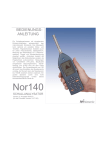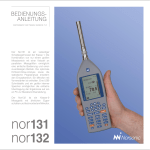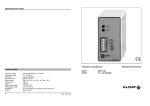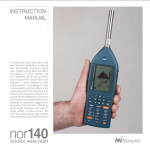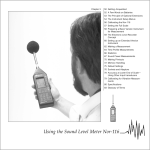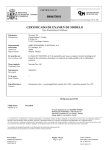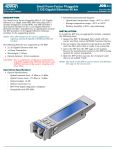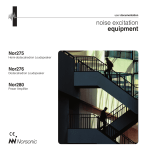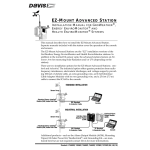Download User Guide Nor265 - Campbell Associates
Transcript
Instruction Manual Im1212_1Ed1R1En May 2004 Outdoor Microphone Kit Nor1212 Instruction Manual Im1212_1Ed1R1En May 2004 Outdoor Microphone Kit Nor1212 Nor1212 – User Guide Im11212_1Ed1R1En – May 2004 edition Norsonic is a registered trademark of Norsonic AS. Every effort has been made to supply complete and accurate information. However, Norsonic AS assumes no responsibility for the use of – or for the consequential damage resulting from the use of – this information and/or the instrumentation described herein. Furthermore, Norsonic AS assumes no responsibility for any infringement of the intellectual property rights of third parties, wherever applicable, which could result from such use. Norsonic AS reserves the right to amend any of the information given in this manual in order to take account of new developments. If you wish to communicate with us, please feel welcome. Our address is: Norsonic AS, P.O. Box 24, N-3421 Lierskogen, Norway e-mail: [email protected] Find us on the web: www.norsonic.com Copyright © Norsonic AS 2004 All rights reserved Norsonic Nor1212 User Guide Contents 1 Introduction......................................................................................................................................... 3 2 Technical description......................................................................................................................... 5 3 Assembling ......................................................................................................................................... 7 3.1 Devices required............................................................................................................................................................7 3.2 Assembling the outdoor microphone unit ....................................................................................................................7 3.3 Mounting on a mast ......................................................................................................................................................8 3.4 Grounding and lightening protection...........................................................................................................................9 4 Microphone Calibration ................................................................................................................... 11 5 Maintenance ...................................................................................................................................... 13 6 Specifications ................................................................................................................................... 15 6.1 Mounting direction .....................................................................................................................................................15 6.2 Acoustic performance .................................................................................................................................................15 6.2.1 Frequency response ................................................................................................................................................15 6.2.2 Directional response ...............................................................................................................................................16 6.3 General ........................................................................................................................................................................20 6.4 Accessories and spare parts ........................................................................................................................................20 1 Norsonic Nor1212 User Guide 1 Introduction The Outdoor microphone kit Nor1212 allows the standard measurement microphone Nor1225 with preamplifier Nor1201 or Nor1206 to be used as an all-weather microphone for semi-permanent applications. The Outdoor Kit protects the microphone from rain and snow, dust and insects. Further, the Outdoor kit improves the measurement accuracy by reducing the wind noise and by changing the directional response of the microphone capsule to suit vertical mounting. The Outdoor Kit allows the Nor1225 microphone to retain its Class 1 specifications according to IEC6051 and IEC61672-1 when the weather protection system is in place. The acoustic sensitivity for free-field measurement microphones, like Nor1225, is optimised for sound reaching the microphone along the axis of symmetry. When mounted for outdoor measurements the microphone is normally mounted with the diaphragm pointing upwards. The microphone response will therefore be at its best for sound from above. Even for aircraft noise monitoring, the sound will seldom approach the microphone just from this direction. The outdoor kit has therefore been designed to change the directional characteristics of the microphone to improve the accuracy in other directions. The result is a microphone with a response almost symmetrical around the horizontal plane and with a flat random incidence response. The Outdoor Kit allows the microphone to be calibrated with a normal sound calibrator without the need for extra accessories. Access to the microphone is gained by dismounting the upper part of the kit. The outdoor kit is made of an electrical insulating material. The microphone body will be fully insulated from the mounting mast thereby reducing pick-up of electrical hum and noise. 3 4 Introduction For improved protection in excessive humid applications, the outdoor kit may be combined with a microphone desiccator or the preamplifier may be heated. Norsonic Nor1212 User Guide 2 Technical description The Outdoor Kit, Nor1212, is designed to operate in combination with Norsonic microphone Nor1225 and the preamplifier Nor1201 or Nor1206. Some other types of free-field microphones such as the Nor1223, Nor1226 and 1227 may also be used with minor modifications of their frequency and directional response as specified for Nor1225. Note that Nor1220 microphone should not to be used with the Outdoor Kit as its uncompensated frequency response may not be within the requirements for a class 1 sound level meter. If you need to connect the microphone system to the measuring instrument with a coaxial cable, we recommend to use the pre-polarised microphone Nor1227 in combination with a suitable ICP® type of preamplifier. We recommend Nor1207 with desiccator TA202 (You need the desiccator due to the size of Nor1207). The outdoor kit Nor1212 protects the normal measurement microphone Nor1225 from rain, dust and insects, which sometimes may creep behind the normal microphone grid. The construction is shown on figure 2.1. Figure 2.1 The sound reaches the microphone through the mesh and acoustic ports. The microphone is mounted inside a tube. The sound enters the microphone through 12 acoustic ports placed equidistantly around the circumference. These ports have a drip-edge to prevent water from entering the tube. For 5 6 Technical description further protection, the ports are covered with a water-repellent mesh. This also prevents the microphone from dust and insects. The tube is made of polyacetal (POM). The material is durable and has a low thermal conductivity compared to metal. This low thermal conductivity will have the effect of raising the temperature of the microphone and preamplifier above the ambient temperature. This heat gain is caused by the power consumption of the preamplifier. Even a small temperature rise will prevent condensation of water within the microphone during humid weather conditions. For applications in extremely humid conductions, the preamplifier Nor 1201 or Nor1206 may be further heated by applying power to the internal heating element. See the handbook for Nor1201 for further details. Alternatively, a desiccator type TA202 may be placed between the microphone and the preamplifier. The desiccator absorbs water and hence provides dry air to the microphones back vent. The desiccator needs to be regenerated from time to time; see section 5 for information about this maintenance operation. Placing the microphone inside a long rod results in the acoustic directional response being almost symmetrical above and below the horizontal plane through the acoustic ports. This makes the microphone system applicable for monitoring of aircraft overhead as well as industryand traffic-sources on the ground. Access to the microphone is achieved by removing the upper part which is simply unscrewed from the main body. The base of the main body is sealed by means of the base screw. This base screw also contains a threaded hole for mounting the microphone system on a mast. Figure 2.2 Microphone system Nor1212 Norsonic Nor1212 User Guide 3 Assembling Upper part 3.1 The Nor1212 Outdoor Kit is designed to operate in combination with Norsonic microphone Nor1225 and the preamplifiers Nor1201 or Nor1206. The description of the assembly in this manual is based on microphone Nor1225 and preamplifier Nor1201. Approx. 11 cm Microphone with preamplifier Fastening nut Devices required In addition to the outdoor kit Nor1212 you need the microphone, the preamplifier and a cable for connection to the measuring instrument. For Norsonic sound level meters, we recommend cable type Nor1408, which comes in standard lengths of 5, 10, 15, 20, 30 and 50 metres – other lengths are available on request. This cable is Teflon®-insulated and hence absorbs very little water, which is very important in order to retain the normal polarisation voltage for the microphone. If you need weatherprotected connectors, we recommend cable type Nor1485. Depending on the application, you will need a mast or tripod for mounting the microphone system and possibly also devices for proper grounding and lightening protection. See below. Main body 3.2 Base screw Assembling the outdoor microphone unit See figures 2.1, 2.2 and 3.1 for a description of the main parts of the outdoor protection kit Nor1212. Remove the upper protection part with the windscreen and the base screw from the main body of the outdoor kit. Figure 3.1 Adjusting the height of the microphone Mount the cable on the preamplifier. Do not mount the microphone. Put the upper part of the preamplifier through the main body of the kit from below. Loosen the fastening nut if necessary. If you want to use the desiccator TA202, mount it on the preamplifier. Mount the microphone on the desiccator or preamplifier as appropriate. 7 8 Assembling Important! Follow the mounting instructions carefully; otherwise, the microphone may be harmed! Adjust the height of the microphone preamplifier assembly to be a slightly higher than the centre of the windscreen, see figure 3.1. (Approximately 11 cm). Tighten the fastening nut just enough so that the preamplifier will not move by its own weight as the microphone will be automatically located to the right position as the two halves are screwed together and it is important that the force used is minimal to prevent damage to the microphone grid. Accurate adjustment of the height of the microphone is very important to maintain the specification for the frequency response. Carefully screw on the upper part; this will press the microphone downward so the top of the microphone grid is placed accurately at the opening for the acoustic ports. Now carefully remove the upper part in order not to alter the height of the microphone. Now tighten the fastening nut using hand force only and do not over-tighten. The purpose of the base screw is threefold: Figure 3.2 The desiccator TA202 is placed between the microphone and the preamplifier. • It is a base for mounting the microphone system on a mast or tripod. • It closes the main body, but has a water drain to let any condensate escape. • It forms a tension relief for the cable. Press the microphone cable slightly towards the preamplifier and mount the base crew at the lower end of the main body. After mounting of the upper protection part, the outdoor microphone unit will be ready for use. However, we recommend that you test the unit together with the measuring instrument by applying a calibrator before the upper part is mounted. 3.3 Mounting on a mast The outdoor microphone assembly may easily be mounted on a supporting mast that has a mounting stud suitable for connection to the Nor1212. The dimensions are given in the section dealing with the specification and are those commonly used on tripods for cameras. Norsonic Nor1212 User Guide If the mast is high and you need to make regular calibrations or other service operations, we recommend the use a tiltable or a telescopic mast. Norsonic can supply different masts on demand. Fasten the microphone cable along the mast properly. A cable flapping onto the mast in windy conditions may create excessive noise and ruin the measurement accuracy. 3.4 Grounding and lightening protection If the outdoor microphone assembly is the highest object in the vicinity when mounted, it may be exposed to lightening strikes. We recommend that the mast, if conductive, is properly grounded. A lightening rod in proper contact with a conductive mast will form a suitable protection against the effects of a lightening strike and a recommended configuration is given below.. The rod should be placed at least 25 cm to the side of the microphone assembly and have a diameter not more than 10 mm in order not to interfere with the direction properties of the microphone. Its height should be at least 10 cm above the tip of the microphone assembly (the microphone is located 14 cm below the insulated tip). If the mast is not conductive, the lightening rod should be connected to a proper lightening conductor. Safety considerations may require that the screen of the microphone cable to be properly grounded. We recommend making the combined grounding for the cable and instrument at one point only in order to reduce the risk of pick-up of hum and electro-magnetic noise. Verify the noise floor of the complete system after installation is completed to ensure it is below the lower end of the required measurement range. If a quiet location is not available, the noise floor may be measured by substituting the microphone with a dummy microphone like Nor1448. As an alternative the Nor1447 adaptor terminated with a short-circuit or a 50 ohm BNC termination is also a suitable device for making this test. Figure 3.3 Lightening protection . 9 Norsonic Nor1212 User Guide 4 Microphone Calibration The outdoor microphone system can be calibrated with a normal sound calibrator without the need for special couplers. We recommend using Nor1251 (1000 Hz) or Nor1253 (250 Hz). The procedure is valid for the microphones Nor1223, Nor1225, Nor1226 and Nor1227. Screw off the upper part of the protector kit to gain access to the microphone. Mount the calibrator and switch it on. See figure 4.1. If the calibrator frequency is 250 Hz, adjust the reading to be the level stated for the calibrator, e.g. 124,0 dB for Nor1253 with 124 dB specified level. If the calibrator frequency is 1000 Hz, adjust the reading to be 0,2 dB below the stated calibrator level, e.g. 113,8 dB for Nor1251 calibrator with a stated level of 114 dB. Figure 4.1 Calibration 11 12 Norsonic Nor1212 User Guide 5 Maintenance The need for maintenance depends largely on the environmental conditions where the microphone system is used. For most semipermanent applications, the maintenance is normally either done before the start or after the end of a measurement. During the measurement normally only periodic checks of the calibration are needed. Before the start of a new measurement, remove the windscreen and verify that it is not contaminated with dust or dirt. The windscreen may be washed by hand using standard washing up detergents only. Ensure that it has been thoroughly rinsed in clean water and is completely dry before it is remounted. Do not use excessive heat for the drying: 60ºC maximum. If used outdoor most of the time, we recommend replacing the windscreen every other year, spare part Nor4520. However in some locations, near to chemical complexes or in coastal installations it may be necessary to replace the windscreen earlier. Figure 5.1 Desiccator TA202 Remove the upper protection part and verify that the mesh covering the acoustic ports is clean and free from dust. You may inspect the mesh by holding it in front of a light source; rotate the upper protection part and look through the holes. Use a soft brush to wipe off any dust or detritus. If heavily polluted, peel off the mesh and replace it with a new; spare part number Norsonic 0896000. The mesh comes with an adhesive. When you mount a new mesh, ensure that the splice is placed midway between the acoustic ports! See figure 2.1. If you use the desiccator, this needs to be dried at regular intervals. This may be attained by placing the desiccator for a few hours at an elevated temperature, e.g. 100ºC. Do not heat beyond 130ºC as this will harm the device. The desiccator TA202 has a small window where you can see the silica gel inside, see figure 5.1. When dry, the gel has a light blue colour. This colour changes to milky-white when the gel is wet and cannot absorb more water. 13 Norsonic Nor1212 User Guide 6 Specifications 6.1 Mounting direction The microphone kit shall be mounted with the tip pointing upwards and the axis of symmetry shall be vertical. The acoustic reference axis for the microphone-assembly is from above, 25º from the vertical axis. 6.2 Acoustic performance 6.2.1 Frequency response The modification of the free-field response and the random incidenceresponse of a Nor1225 microphone when placed in the outdoor kit Nor1212 is shown on the diagram below together with the requirements for a Class 1 sound level meter according to IEC61672-1. Both the free field and the random incidence-response shown are referred to the freefield response for Nor1225 microphone without the protection kit. 15 16 Specifications Correction to microphone free-field response +5 0 -5 -10 100 200 300 500 1k 2k 3k 5k 10k 20k Frequency [Hz] Free-field response Random-incidence response Tolerance limits with uncertainty. IEC 61672-1 Class 1 6.2.2 Directional response The directional response satisfies the requirements for a Class 1 sound level meter according to IEC61672-1. The figures on the next pages show the directional response in detail in a plane through the horizontal and vertical axis of symmetry. Norsonic Nor1212 User Guide 0o +7 dB -5 dB 90o 270o -5 dB Directional response Horizontal plane 1k, 2k, 4k, 6.3k. 8k, 10k. 12,5k and 16kHz +7 dB 180o 1 k, 2k, ...16kHz 17 18 Specifications Reference direction 0o +7 dB 6,3 kHz 4 kHz -5 dB 6,3 kHz 90o 270o 2 kHz 1 kHz -5 dB Directional response Vertical plane 1k, 2k, 4k and 6.3kHz +7 dB 180o Norsonic Nor1212 User Guide Reference direction 0o 16 kHz +7 dB 12,5 kHz 10 kHz 8 kHz -5 dB 90o 270o -5 dB Directional response Vertical plane 8k, 10k. 12,5k and 16kHz +7 dB 180o 19 20 Specifications 6.3 General Mounting thread: 3/8" UNC Temperature range: -25ºC to +50ºC Height: 45 cm Diameter: Approx 5 cm with windshield Weight: 220 g 6.4 Conformity The device is in conformity with the following standards: EN-50081-1 EN-50082-1 6.5 Accessories and spare parts Desiccator: TA202 Windshield: Nor4520. Dust-mesh: Norsonic part no 0896000. Microphone: Nor1225 Microphone preamplifier: Nor1201, Nor1206 or Nor1207 Sound calibrator: Nor1251 or Nor1253 Microphone cable: Nor1408 Standard lengths 5, 10, 15, 20, 30 and 50 metres – other lengths on request. Dummy microphone: Nor1448 (18 pF) or Nor1447 with a short-circuit. P.O.Box 24 N-3421 Lierskogen Norway www.norsonic.com


























